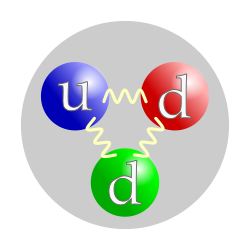Neutrons

|
|
| Classification | Baryon |
|---|---|
| Composition | 1 up quark, 2 down quarks |
| Statistics | Fermionic |
| Interactions | Gravity, weak, strong, electromagnetic |
| Symbol |
n , n0 , N0 |
| Antiparticle | Antineutron |
| Theorized | Ernest Rutherford (1920) |
| Discovered | James Chadwick (1932) |
| Mass |
1.674927471(21)×10−27 kg 939.5654133(58) MeV/c2 1.00866491588(49) u |
| Mean lifetime | 881.5(15) s (free) |
| Electric charge |
0 e |
| Electric dipole moment | < 2.9×10−26 e⋅cm (experimental upper limit) |
| Electric polarizability | 1.16(15)×10−3 fm3 |
| Magnetic moment |
−0.96623650(23)×10−26 J·T−1 −1.04187563(25)×10−3 μB −1.91304273(45) μN |
| Magnetic polarizability | 3.7(20)×10−4 fm3 |
| Spin | 1/2 |
| Isospin | −1/2 |
| Parity | +1 |
| Condensed | I(JP) = 1/2(1/2+) |
0 e
The neutron is a subatomic particle, symbol
n
or
n0
, with no net electric charge and a mass slightly larger than that of a proton. Protons and neutrons, each with mass approximately one atomic mass unit, constitute the nucleus of an atom, and they are collectively referred to as nucleons. Their properties and interactions are described by nuclear physics.
The nucleus consists of Z protons, where Z is called the atomic number, and N neutrons, where N is the neutron number. The atomic number defines the chemical properties of the atom, and the neutron number determines the isotope or nuclide. The terms isotope and nuclide are often used synonymously, but they are chemical and nuclear concepts, respectively. The atomic mass number, symbol A, equals Z+N. For example, carbon has atomic number 6, and its abundant carbon-12 isotope has 6 neutrons, whereas its rare carbon-13 isotope has 7 neutrons. Some elements occur in nature with only one stable isotope, such as fluorine. Other elements occur with many stable isotopes, such as tin with ten stable isotopes. Even though it is not a chemical element, the neutron is included in the table of nuclides.
...
Wikipedia
